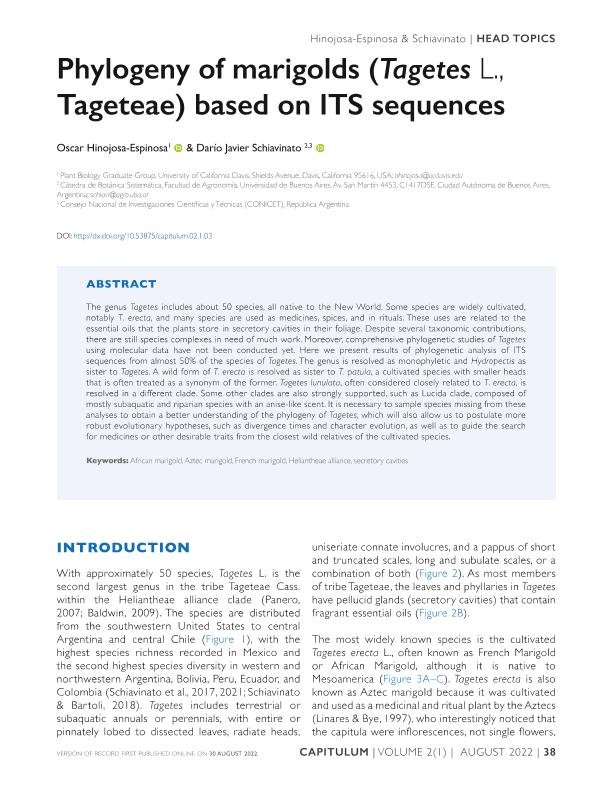Mostrar el registro sencillo del ítem
dc.contributor.author
Hinojosa Espinosa, Oscar
dc.contributor.author
Schiavinato, Dario Javier

dc.date.available
2023-06-23T16:32:45Z
dc.date.issued
2022-08
dc.identifier.citation
Hinojosa Espinosa, Oscar; Schiavinato, Dario Javier; Phylogeny of marigolds (Tagetes L., Tageteae) based on ITS sequences; The International Compositae Alliance; Capitulum; 2; 8-2022; 38-49
dc.identifier.issn
2789-2786
dc.identifier.uri
http://hdl.handle.net/11336/201320
dc.description.abstract
The genus Tagetes includes about 50 species, all native to the New World. Some species are widely cultivated, notably T. erecta, and many species are used as medicines, spices, and in rituals. These uses are related to the essential oils that the plants store in secretory cavities in their foliage. Despite several taxonomic contributions, there are still species complexes in need of much work. Moreover, comprehensive phylogenetic studies of Tagetes using molecular data have not been conducted yet. Here we present results of phylogenetic analysis of ITS sequences from almost 50% of the species of Tagetes. The genus is resolved as monophyletic and Hydropectis as sister to Tagetes. A wild form of T. erecta is resolved as sister to T. patula, a cultivated species with smaller heads that is often treated as a synonym of the former. Tagetes lunulata, often considered closely related to T. erecta, is resolved in a different clade. Some other clades are also strongly supported, such as Lucida clade, composed of mostly subaquatic and riparian species with an anise-like scent. It is necessary to sample species missing from these analyses to obtain a better understanding of the phylogeny of Tagetes, which will also allow us to postulate more robust evolutionary hypotheses, such as divergence times and character evolution, as well as to guide the search for medicines or other desirable traits from the closest wild relatives of the cultivated species.
dc.format
application/pdf
dc.language.iso
eng
dc.publisher
The International Compositae Alliance
dc.rights
info:eu-repo/semantics/openAccess
dc.rights.uri
https://creativecommons.org/licenses/by-nc-sa/2.5/ar/
dc.subject
AFRICAN MARIGOLD
dc.subject
AZTEC MARIGOLD
dc.subject
FRENCH MARIGOLD
dc.subject
HELIANTHEAE ALLIANCE
dc.subject
SECRETORY CAVITIES
dc.subject.classification
Ciencias de las Plantas, Botánica

dc.subject.classification
Ciencias Biológicas

dc.subject.classification
CIENCIAS NATURALES Y EXACTAS

dc.title
Phylogeny of marigolds (Tagetes L., Tageteae) based on ITS sequences
dc.type
info:eu-repo/semantics/article
dc.type
info:ar-repo/semantics/artículo
dc.type
info:eu-repo/semantics/publishedVersion
dc.date.updated
2023-06-23T14:58:47Z
dc.journal.volume
2
dc.journal.pagination
38-49
dc.journal.pais
Uruguay

dc.description.fil
Fil: Hinojosa Espinosa, Oscar. University of California at Davis; Estados Unidos
dc.description.fil
Fil: Schiavinato, Dario Javier. Consejo Nacional de Investigaciones Científicas y Técnicas; Argentina. Universidad de Buenos Aires. Facultad de Agronomía; Argentina
dc.journal.title
Capitulum
dc.relation.alternativeid
info:eu-repo/semantics/altIdentifier/url/http://www.fagro.edu.uy/~bioveg/capitulum02_1_03.html
dc.relation.alternativeid
info:eu-repo/semantics/altIdentifier/doi/http://dx.doi.org/10.53875/capitulum.02.1.03
Archivos asociados
